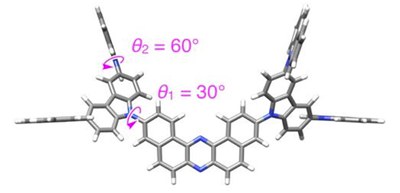
VDW porous crystal crystal with hydrochromic properties developed
A group of researchers from Tsukuba University, Osaka University, Kyushu University, The University of Tokyo, the Japan Synchrotron Radiation Research Institute (JASRI), Tokyo Institute of Technology, Rigaku Corporation, and University of Malaga (Spain) has developed a porous van der Waals (VDW) crystal with hydrochromic properties that exhibits reversible color change through humidity.
The phenomena of reversible changes in object color induced by gas or vapor is referred to as vapochromism. Silica gel beads, which turn blue to red as they absorb moisture, are well known as moisture indicators. However, chemical bonds that underpin the frameworks of porous crystals (such as coordination bonds, dynamic covalent bonds, and hydrogen bonds) are commonly affected by the water molecules.
This group created a porous crystal VPC-1 by stitching organic molecules together not by reticular intermolecular bonding networks, but by much weaker interactions such as VDW forces. Although its constituent molecules are connected via VDW forces, VPC-1 can maintain its structural integrity and vacant pores even after removal of crystallization solvent molecules.
This hydrochromic VDW porous crystal VPC-1 consists of a newly synthesized second-generation dendrimer 1 having a planar dibenzo[a,j]phenazine (DBPHZ) core with two branched carbazole (Cz) dendrons. VPC-1 accommodates guest gaseous molecules inside it and exhibits reversible color changes upon uptake/release of water molecules due to the charge transfer character of the constituent dendrimer.
VPC-1 also displays a linear correlation against the solvent polarity, which indicates that the color of VPC-1 is affected by the high permittivity of the guest H2O molecules. Color change of VPC-1 from yellow to red is enhanced along with the bathochromic solvatochromism. The H2O uptake/release triggered visible color change between red and yellow with a steep threshold at a relative humidity (RH) around 50% at 25 °C, but the crystals preserved its lattice structure upon uptake/release of H2O molecules.
Spectroscopic and X-ray diffractometry studies revealed the synchronous twisting of the outermost Cz units of 1 upon H2O adsorption. A thermodynamic analysis of the isotherms disclosed the affinity transition of the pore surface from hydrophobic to hydrophilic, which was responsible for the simultaneous twisting of the Cz units.
Since VPC-1 is made up of organic molecules, strict humidity control and fast humidity sensing are possible by controlling humidity levels to cause color change, increasing the number of colors, and improving the sensitivity level.
This group designed a microporous crystal without bonded frameworks, which had been thought to be essential for forming a microporous structure. Their method enhanced the water resistance of chemical bonds that hold organic molecules together, which will expand the degree of freedom in molecular design for porous crystals.
Figure 1
Figure 2
Figure 3
Figure 4
The article, “Sigmoidally hydrochromic molecular porous crystal with rotatable dendrons”, will be published in Communications Chemistry at DOI: https://www.nature.com/articles/s42004-020-00364-3.
